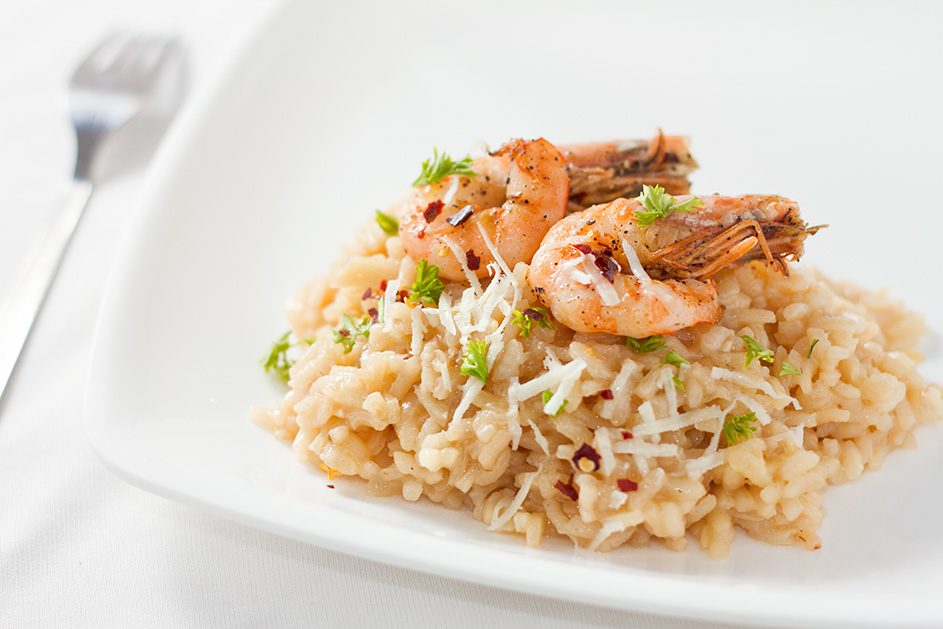Roasted Shrimp Risotto
2015-03-13- Cuisine: Italian
- Course: Main Course, One Dish Meal
- Skill Level: Advanced
- Yield : 300 gms
- Servings : 2
- Prep Time : 25m
- Cook Time : 35m
- Ready In : 60m
Roasted Shrimp Risotto has become my favourite risotto not just because it is so flavourful, but also because I cherish the memories associated with it. Risotto is a meal that is not just eaten together but also cooked together, with family or a friend. It is not too demanding, just needs stirring and ladling so you keep sipping your wine, and chatting.It is the process of cooking risotto that makes it fun.
In our minds, risotto is a exotic dish that we order at the restaurants and not cook at home. In reality, it is a simple home style dish, not difficult to cook and extremely comforting. Given time we perfect the recipe, but the process of making it is so soothing that even if it does not cook quite right the first few times, we enjoy sharing and eating it.
Ingredients
- Large shrimps 6
- Olive Oil 1 Tbsp
- Chilli flakes 1 Tsp
- Chicken broth 1.5 liters
- Butter - 3 Tbsp
- White onion 1 chopped finely
- Garlic, 5 cloves minced
- 1 cups Arborio rice
- 1/2 cup white wine
- 1 cup grated Parmesan cheese
- 1 cup finely chopped Italian parsley, divided
- Black pepper powder freshly ground to taste
- Salt to taste
Method
Step 1
Rinse the shrimp and pat them very dry. Toss them with olive oil , pepper flakes and generous quantity of salt and pepper
Step 2
In a deep pan, melt butter over medium heat and saute onion and garlic till they are soft. Add the rice and stir thoroughly so that it gets coated with the butter, onion and garlic mixture.
Step 3
Keep stirring the rice for about a minute and then deglaze the pan with the white wine, stirring and scraping the pan until the wine has evaporated.
Step 4
Start adding the warm chicken broth incrementally to the pan, one ladle at a time, and stir the rice frequently. Before adding another ladle full of broth, wait till the liquid is almost completely absorbed by the rice. If you find the broth evaporating very fast, reduce the heat. The gradual addition of broth is very important to get the creamy consistency of the Risotto.
Step 5
After about 14 minutes start testing the rice for doneness. The risotto is ready when the rice is still a bit chewy, and when you crush a grain between your fingers, it gets completely mashed. The risotto at this point should be of the consistency of a thick porridge.
Step 6
In the last 5 minutes of the cooking of risotto, shallow fry the shrimps till done. Shirmps cook very very fast and you know they are done when they turn pink.
Step 7
Stir in most of the Parmesan and half the chopped parsley in the risotto and switch off the burner.
Step 8
To serve spread the risotto in the pasta plate and top it up with shrimps and garnish with grated Parmesan and chopped parsley.
Trivia
There are many different risotto recipes with different ingredients, but they are all based on rice of an appropriate variety cooked in a standard procedure.
The rice is first cooked briefly in a soffritto of onion and butter or olive oil to coat each grain in a film of fat, called tostatura; white or red wine is added and has to be absorbed by the grains. When it has evaporated, the heat is raised to medium high and very hot stock is gradually added in small amounts while stirring gently, almost constantly: stirring loosens the starch molecules from the outside of the rice grains into the surrounding liquid, creating a smooth creamy-textured liquid. At that point it is taken off the heat for the mantecatura when diced cold butter is vigorously stirred in to make the texture as creamy and smooth as possible. It may be removed from the heat a few minutes earlier, and left to cook with its residual heat.
Properly cooked risotto is rich and creamy but still with some resistance or bite: al dente, and with separate grains. The traditional texture is fairly fluid, or all’onda (“wavy, or flowing in waves”). It is served on flat dishes and it should easily spread out but not have excess watery liquid around the perimeter. It must be eaten at once as it continues to cook in its own heat and can become too dry with the grains too soft.
Source: Wikipedia


